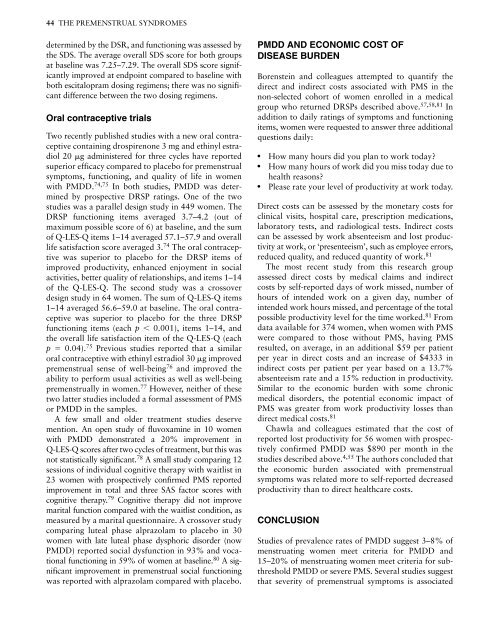Premenstrual Syndromes : PMS and PMDD - Rutuja :: The site ...
Premenstrual Syndromes : PMS and PMDD - Rutuja :: The site ...
Premenstrual Syndromes : PMS and PMDD - Rutuja :: The site ...
You also want an ePaper? Increase the reach of your titles
YUMPU automatically turns print PDFs into web optimized ePapers that Google loves.
44 THE PREMENSTRUAL SYNDROMES<br />
determined by the DSR, <strong>and</strong> functioning was assessed by<br />
the SDS. <strong>The</strong> average overall SDS score for both groups<br />
at baseline was 7.25–7.29. <strong>The</strong> overall SDS score significantly<br />
improved at endpoint compared to baseline with<br />
both escitalopram dosing regimens; there was no significant<br />
difference between the two dosing regimens.<br />
Oral contraceptive trials<br />
Two recently published studies with a new oral contraceptive<br />
containing drospirenone 3 mg <strong>and</strong> ethinyl estradiol<br />
20 �g administered for three cycles have reported<br />
superior efficacy compared to placebo for premenstrual<br />
symptoms, functioning, <strong>and</strong> quality of life in women<br />
with <strong>PMDD</strong>. 74,75 In both studies, <strong>PMDD</strong> was determined<br />
by prospective DRSP ratings. One of the two<br />
studies was a parallel design study in 449 women. <strong>The</strong><br />
DRSP functioning items averaged 3.7–4.2 (out of<br />
maximum possible score of 6) at baseline, <strong>and</strong> the sum<br />
of Q-LES-Q items 1–14 averaged 57.1–57.9 <strong>and</strong> overall<br />
life satisfaction score averaged 3. 74 <strong>The</strong> oral contraceptive<br />
was superior to placebo for the DRSP items of<br />
improved productivity, enhanced enjoyment in social<br />
activities, better quality of relationships, <strong>and</strong> items 1–14<br />
of the Q-LES-Q. <strong>The</strong> second study was a crossover<br />
design study in 64 women. <strong>The</strong> sum of Q-LES-Q items<br />
1–14 averaged 56.6–59.0 at baseline. <strong>The</strong> oral contraceptive<br />
was superior to placebo for the three DRSP<br />
functioning items (each p � 0.001), items 1–14, <strong>and</strong><br />
the overall life satisfaction item of the Q-LES-Q (each<br />
p � 0.04). 75 Previous studies reported that a similar<br />
oral contraceptive with ethinyl estradiol 30 �g improved<br />
premenstrual sense of well-being 76 <strong>and</strong> improved the<br />
ability to perform usual activities as well as well-being<br />
premenstrually in women. 77 However, neither of these<br />
two latter studies included a formal assessment of <strong>PMS</strong><br />
or <strong>PMDD</strong> in the samples.<br />
A few small <strong>and</strong> older treatment studies deserve<br />
mention. An open study of fluvoxamine in 10 women<br />
with <strong>PMDD</strong> demonstrated a 20% improvement in<br />
Q-LES-Q scores after two cycles of treatment, but this was<br />
not statistically significant. 78 A small study comparing 12<br />
sessions of individual cognitive therapy with waitlist in<br />
23 women with prospectively confirmed <strong>PMS</strong> reported<br />
improvement in total <strong>and</strong> three SAS factor scores with<br />
cognitive therapy. 79 Cognitive therapy did not improve<br />
marital function compared with the waitlist condition, as<br />
measured by a marital questionnaire. A crossover study<br />
comparing luteal phase alprazolam to placebo in 30<br />
women with late luteal phase dysphoric disorder (now<br />
<strong>PMDD</strong>) reported social dysfunction in 93% <strong>and</strong> vocational<br />
functioning in 59% of women at baseline. 80 A significant<br />
improvement in premenstrual social functioning<br />
was reported with alprazolam compared with placebo.<br />
<strong>PMDD</strong> AND ECONOMIC COST OF<br />
DISEASE BURDEN<br />
Borenstein <strong>and</strong> colleagues attempted to quantify the<br />
direct <strong>and</strong> indirect costs associated with <strong>PMS</strong> in the<br />
non-selected cohort of women enrolled in a medical<br />
group who returned DRSPs described above. 57,58,81 In<br />
addition to daily ratings of symptoms <strong>and</strong> functioning<br />
items, women were requested to answer three additional<br />
questions daily:<br />
● How many hours did you plan to work today?<br />
● How many hours of work did you miss today due to<br />
health reasons?<br />
● Please rate your level of productivity at work today.<br />
Direct costs can be assessed by the monetary costs for<br />
clinical visits, hospital care, prescription medications,<br />
laboratory tests, <strong>and</strong> radiological tests. Indirect costs<br />
can be assessed by work absenteeism <strong>and</strong> lost productivity<br />
at work, or ‘presenteeism’, such as employee errors,<br />
reduced quality, <strong>and</strong> reduced quantity of work. 81<br />
<strong>The</strong> most recent study from this research group<br />
assessed direct costs by medical claims <strong>and</strong> indirect<br />
costs by self-reported days of work missed, number of<br />
hours of intended work on a given day, number of<br />
intended work hours missed, <strong>and</strong> percentage of the total<br />
possible productivity level for the time worked. 81 From<br />
data available for 374 women, when women with <strong>PMS</strong><br />
were compared to those without <strong>PMS</strong>, having <strong>PMS</strong><br />
resulted, on average, in an additional $59 per patient<br />
per year in direct costs <strong>and</strong> an increase of $4333 in<br />
indirect costs per patient per year based on a 13.7%<br />
absenteeism rate <strong>and</strong> a 15% reduction in productivity.<br />
Similar to the economic burden with some chronic<br />
medical disorders, the potential economic impact of<br />
<strong>PMS</strong> was greater from work productivity losses than<br />
direct medical costs. 81<br />
Chawla <strong>and</strong> colleagues estimated that the cost of<br />
reported lost productivity for 56 women with prospectively<br />
confirmed <strong>PMDD</strong> was $890 per month in the<br />
studies described above. 4,55 <strong>The</strong> authors concluded that<br />
the economic burden associated with premenstrual<br />
symptoms was related more to self-reported decreased<br />
productivity than to direct healthcare costs.<br />
CONCLUSION<br />
Studies of prevalence rates of <strong>PMDD</strong> suggest 3–8% of<br />
menstruating women meet criteria for <strong>PMDD</strong> <strong>and</strong><br />
15–20% of menstruating women meet criteria for subthreshold<br />
<strong>PMDD</strong> or severe <strong>PMS</strong>. Several studies suggest<br />
that severity of premenstrual symptoms is associated


